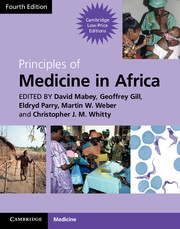Book contents
- Frontmatter
- Contents
- Contributors
- Foreword
- Section 1 Health and disease
- Section 2 Mother and child health
- Section 3 Infection: general principles
- Section 4 Major common infections
- Section 5 Bacterial infections
- Section 6 Viral Infections
- Section 7 Protozoal infections
- Section 8 Helminth infections
- Section 9 Fungal infections
- Section 10 Non-communicable diseases
- 56 Chronic and non-communicable disease in Africa
- 57 Chronic non-communicable disease in health care
- 58 Diabetes mellitus
- 59 Hypertension
- 60 Stroke
- 61 Epilepsy
- 62 Mental health
- 63 Asthma, chronic obstructive pulmonary disease (COPD) and exposure to indoor air pollution
- 64 The disabled patient
- Section 11 Diseases of body systems
- Section 12 Cancer and Palliative Care
- Section 13 Venoms and Poisons
- Index
- References
64 - The disabled patient
from Section 10 - Non-communicable diseases
Published online by Cambridge University Press: 05 March 2013
- Frontmatter
- Contents
- Contributors
- Foreword
- Section 1 Health and disease
- Section 2 Mother and child health
- Section 3 Infection: general principles
- Section 4 Major common infections
- Section 5 Bacterial infections
- Section 6 Viral Infections
- Section 7 Protozoal infections
- Section 8 Helminth infections
- Section 9 Fungal infections
- Section 10 Non-communicable diseases
- 56 Chronic and non-communicable disease in Africa
- 57 Chronic non-communicable disease in health care
- 58 Diabetes mellitus
- 59 Hypertension
- 60 Stroke
- 61 Epilepsy
- 62 Mental health
- 63 Asthma, chronic obstructive pulmonary disease (COPD) and exposure to indoor air pollution
- 64 The disabled patient
- Section 11 Diseases of body systems
- Section 12 Cancer and Palliative Care
- Section 13 Venoms and Poisons
- Index
- References
Summary
Introduction
This chapter is different to many others in this book. It is not concerned with specific diseases, their pathology and treatment, but rather with the chronic effect of disabling diseases on patients and their community, and the role that the health worker has in helping those who have disabling conditions. Most health workers in Africa will be involved in some way with people who have disabilities, but even if their direct professional involvement is minimal, they will always be looked at as role models for the community's relationship with disabled people. Therefore, every health worker must understand the subject of disability and how to promote the rehabilitation and employment of the disabled, if they are to be of help to them. The focus is on the individual person, not on the disability.
If health workers are seen to focus on the disability, and not the person, then the community is likely to do the same, and disabled people may feel labelled by their disability. If, however, the health worker focuses first on the person, rather than on his or her disability, then the community is also likely to adopt the same attitude. People with disabilities may then become more welcomed and integrated into the community.
- Type
- Chapter
- Information
- Principles of Medicine in Africa , pp. 578 - 583Publisher: Cambridge University PressPrint publication year: 2013



